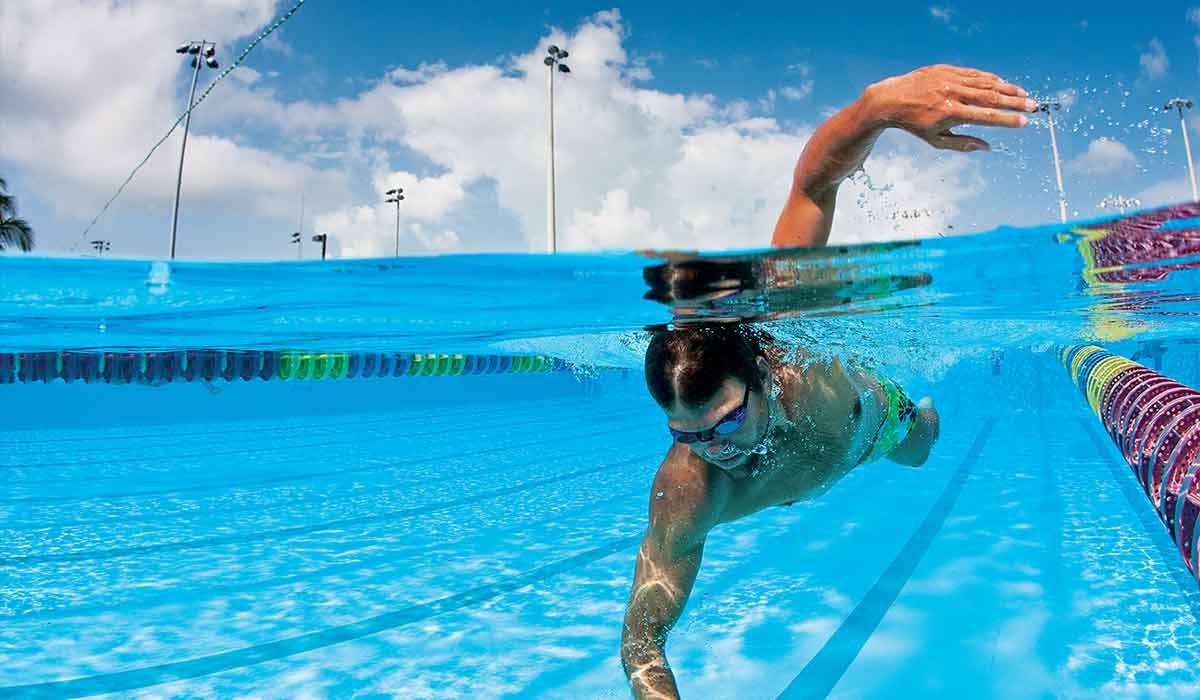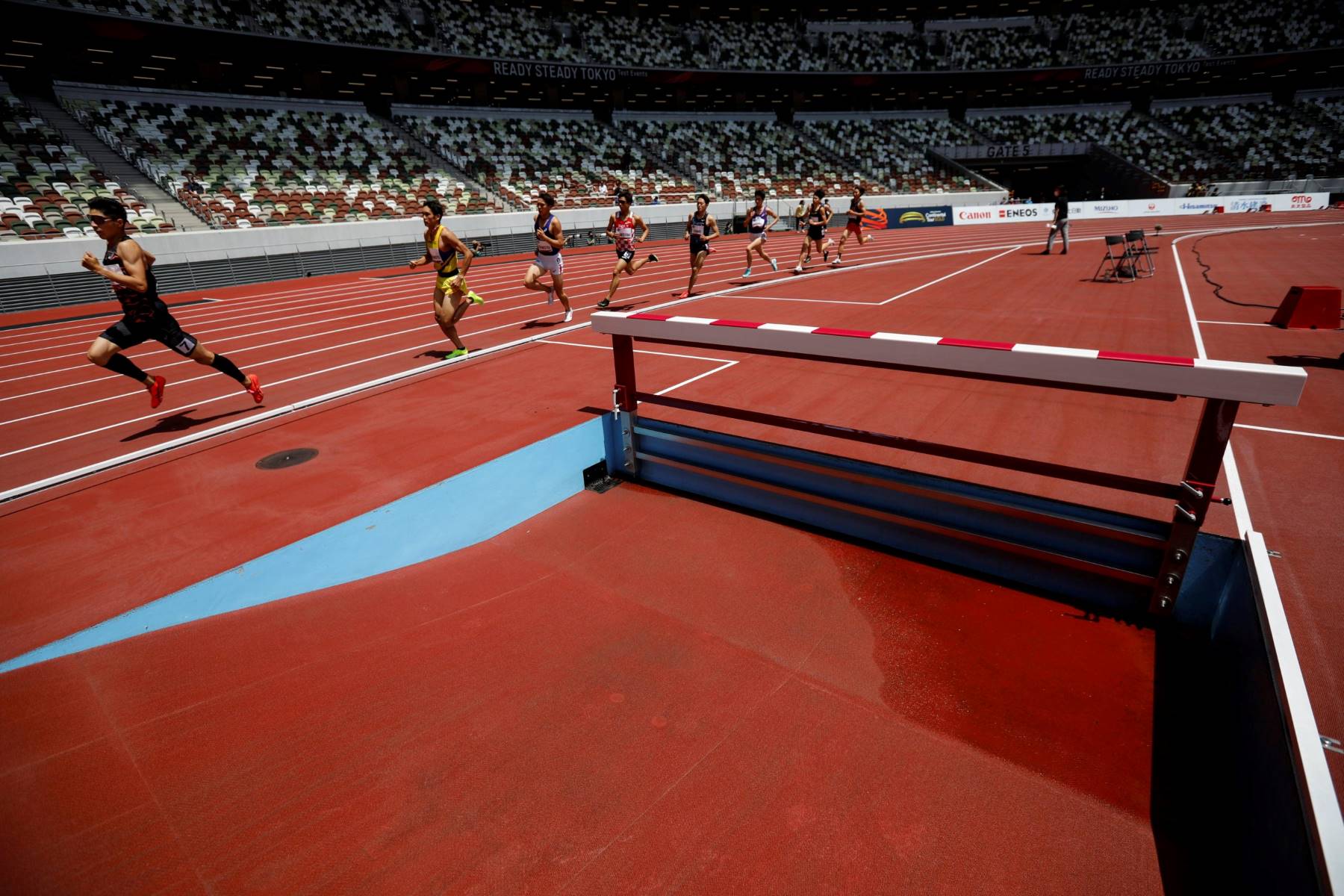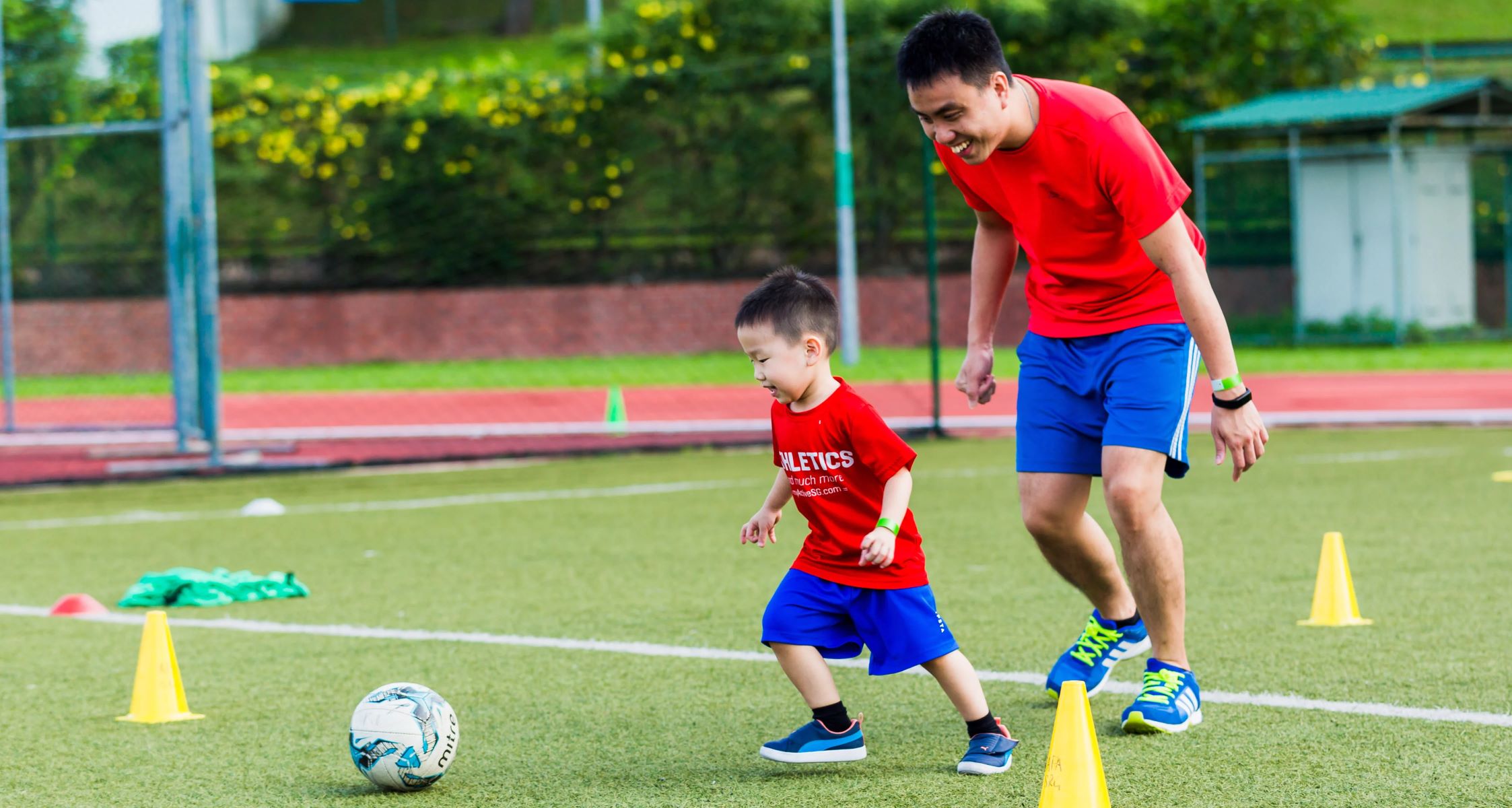Home>Misc>Featured>How To Train Distance Running And Weightlifting


Featured
How To Train Distance Running And Weightlifting
Modified: August 21, 2023
Learn how to effectively train for distance running and weightlifting at the same time with our featured expert tips and strategies. Get the best of both worlds and reach your fitness goals faster.
Introduction
When it comes to overall fitness and athletic performance, distance running and weightlifting are two popular and effective forms of exercise. While distance running focuses on building cardiovascular endurance, weightlifting aims to increase strength and muscle mass. The combination of these two types of training can provide a well-rounded fitness regimen.
The benefits of incorporating distance running and weightlifting into your fitness routine are numerous. Distance running helps improve cardiovascular health, strengthens muscles, and increases stamina. On the other hand, weightlifting builds strength, power, and muscular endurance. Together, they create a synergistic effect that can enhance athletic performance, improve body composition, and boost overall fitness levels.
However, it is essential to approach this dual training approach with proper conditioning and a balanced plan. Overtraining or neglecting certain areas can lead to injuries and hinder progress. Finding the right balance between distance running and weightlifting is crucial for optimal results.
Throughout this article, we will explore various aspects of training in both distance running and weightlifting. We will discuss warm-up and cool-down routines, essential running techniques, effective weightlifting exercises, cross-training methods, goal-setting strategies, nutrition and hydration tips, injury prevention strategies, recovery and rest days, and the mental preparation required to excel in both disciplines.
By understanding the unique demands of distance running and weightlifting, and by following a comprehensive training plan that incorporates both activities, you can achieve your fitness goals and reach new heights in your athletic performance.
Benefits of Distance Running and Weightlifting
Distance running and weightlifting offer a multitude of benefits for both physical and mental well-being. Incorporating both activities into your fitness routine can yield remarkable results. Let’s explore the advantages of each:
- Distance Running: Running is a full-body workout that engages multiple muscle groups, strengthens bones, and improves cardiovascular health. By regularly engaging in distance running, you can enhance your endurance, increase lung capacity, and lower your resting heart rate. Running also promotes weight loss, as it is a highly effective calorie-burning activity. Furthermore, it has been linked to improving mood, reducing stress levels, and boosting overall mental wellness.
- Weightlifting: Weightlifting, on the other hand, focuses on building strength, toning muscles, and improving overall body composition. By lifting weights, you can increase bone density, prevent muscle loss, and enhance joint stability. Weightlifting also boosts metabolism, leading to increased calorie burn even during rest. Moreover, weightlifting can improve posture, increase confidence, and promote better quality sleep.
When combined, distance running and weightlifting complement each other to provide a comprehensive fitness regimen. By engaging in both activities, you can experience accelerated fat loss, improved cardiovascular performance, enhanced muscular strength and endurance, and increased overall fitness level.
Furthermore, distance running and weightlifting have a positive impact on mental health. They release endorphins, known as “feel-good” hormones, which promote a sense of well-being and can help alleviate symptoms of anxiety and depression. These activities also require focus, determination, and discipline, helping to cultivate mental resilience and improve self-confidence.
Additionally, the benefits of distance running and weightlifting extend beyond the physical and mental aspects. Engaging in these activities can foster a sense of community and provide opportunities to meet like-minded individuals who share similar fitness goals. The support and camaraderie found in running clubs and weightlifting communities can further motivate and inspire you on your fitness journey.
Overall, the combination of distance running and weightlifting offers a wide range of benefits for your physical, mental, and social well-being. The synergistic effect of these activities can empower you to achieve your fitness goals, lead a healthy lifestyle, and unlock your full potential.
Importance of Proper Conditioning
Proper conditioning is crucial when engaging in distance running and weightlifting. It involves preparing your body physically and mentally for the demands of these activities. Without proper conditioning, you increase the risk of injury, hinder your progress, and may not be able to achieve your desired results. Let’s explore the importance of proper conditioning in more detail:
1. Injury Prevention: A well-conditioned body is less prone to injuries. Regular training and conditioning help strengthen muscles, improve flexibility, and enhance joint stability. This reduces the risk of strains, sprains, and other common running and weightlifting injuries. Proper conditioning also focuses on strengthening weak areas and correcting imbalances, ensuring that your body can withstand the demands of these activities.
2. Performance Enhancement: Conditioning plays a significant role in improving performance. By gradually increasing the intensity and duration of your workouts, you build endurance, stamina, and strength. This allows you to run longer distances, lift heavier weights, and perform better in both disciplines. Conditioning also improves your running efficiency, enabling you to maintain proper form and technique, resulting in more efficient energy usage.
3. Adaptation to Training Load: Distance running and weightlifting can be physically demanding. Proper conditioning helps your body adapt to the stress placed on it during training. By gradually increasing the workload and incorporating rest and recovery days, you allow your body to adapt and become more resilient. This prevents overexertion and overtraining, which can lead to burnout and potential setbacks in your fitness journey.
4. Mental Preparation: Conditioning not only focuses on physical aspects but also on mental preparation. Engaging in regular training builds discipline, mental toughness, and determination. It helps develop a positive mindset and the ability to push through challenges and obstacles. Proper conditioning enhances focus and concentration during workouts, leading to improved performance and better overall results.
5. Sustainable Progress: Conditioning sets the foundation for long-term progress and sustainable results. By starting with appropriate training levels and gradually increasing the intensity and volume, you avoid overwhelming your body and ensure steady improvement. Proper conditioning allows you to build a solid fitness base, preventing burnout and promoting consistency in your training.
In summary, proper conditioning is crucial for optimizing your performance, preventing injuries, and achieving long-term success in distance running and weightlifting. By gradually increasing the workload, focusing on both physical and mental aspects, and allowing your body to adapt and recover, you set yourself up for sustainable progress and a rewarding fitness journey.
Finding the Right Balance
When incorporating distance running and weightlifting into your fitness routine, finding the right balance between the two is essential. While both activities offer unique benefits, neglecting one or favoring the other can lead to imbalances, hinder progress, and increase the risk of overuse injuries. Here are some key considerations for finding the right balance:
1. Assess Your Goals: Start by identifying your fitness goals and priorities. Determine whether you aim to improve your running performance, increase strength and muscle mass, or achieve a balance between the two. Understanding your goals will help you allocate the right amount of time and energy to each activity.
2. Time Allocation: Consider how much time you can devote to both distance running and weightlifting. Evaluate your schedule and determine how many days per week you can commit to each activity. Finding a balance may involve alternating between running and weightlifting days or engaging in both activities on the same day, depending on your preferences and availability.
3. Intensity and Volume: Adjust the intensity and volume of your workouts based on your goals and fitness level. If you prioritize running, you may opt for longer distances or more frequent runs. If weightlifting is your focus, you may choose heavier weights and lower rep ranges. Experiment with different combinations and listen to your body to find the right balance that challenges you without causing excessive fatigue or stress.
4. Recovery and Rest: Adequate rest and recovery are crucial for optimal performance and injury prevention. Allow for rest days between intense workouts to give your body time to repair and regenerate. Incorporate active recovery exercises such as foam rolling, stretching, and light aerobic activities to enhance recovery. Balancing intense training with rest ensures that you avoid overtraining and keep your body in optimal condition.
5. Periodization: Consider implementing a periodization plan to systematically vary the intensity and volume of your training over specific periods. This approach helps prevent plateaus, keeps your body challenged, and promotes continuous progress. Periodization can be applied to both distance running and weightlifting by incorporating phases of higher and lower intensity or focusing on specific training goals during different periods.
6. Listen to Your Body: Pay attention to how your body responds to the training load and adjust accordingly. If you experience persistent pain or fatigue, it may be a sign that you need to modify your routine or reduce the intensity. Remember that finding the right balance is a dynamic process that may require adjustments as you progress and adapt to new challenges.
By finding the right balance between distance running and weightlifting, you can maximize the benefits of both activities and achieve a well-rounded fitness routine. Experiment, listen to your body, and be flexible in your approach to discover the optimal balance that works for you.
Warm-Up and Cool-Down Routines
Implementing proper warm-up and cool-down routines is crucial for injury prevention, improved performance, and enhanced recovery when engaging in distance running and weightlifting. These routines help prepare your body for the demands of the workouts and aid in recovery afterward. Let’s explore the importance of warm-up and cool-down routines in more detail:
Warm-Up: A warm-up is essential to increase blood flow to muscles, increase body temperature, and prepare the body for physical activity. It helps activate the muscles, improve joint mobility, and mentally transition into the upcoming workout. A well-rounded warm-up routine for distance running and weightlifting should include:
- Cardiovascular Exercise: Begin with light aerobic activities such as jogging, cycling, or jumping jacks to raise your heart rate and warm up your muscles.
- Dynamic Stretching: Engage in dynamic stretching exercises that mimic the movements you will perform during your workout. This helps prepare your muscles for the specific actions they will undergo.
- Activation Exercises: Perform activation exercises that target the muscles you will primarily use during your workout. These exercises activate and engage specific muscle groups, ensuring they are ready for the upcoming workload.
- Practice Drills: Incorporate practice drills that focus on running form, stride mechanics, or weightlifting technique. These drills help reinforce proper movement patterns and prepare your body for the specific activities you will be performing.
Cool-Down: After completing your workout, it is crucial to allow for a proper cool-down period. Cool-down routines help gradually decrease your heart rate, flush out metabolic waste products, and promote muscle recovery. A comprehensive cool-down routine for distance running and weightlifting should include:
- Low-Intensity Cardiovascular Exercise: Engage in low-impact activities such as walking or light jogging to gradually reduce your heart rate and bring your body back to a resting state.
- Stretching: Perform static stretching exercises to stretch and lengthen the muscles that were used during your workout. This helps improve flexibility, reduce muscle soreness, and enhance recovery.
- Foam Rolling or Self-Myofascial Release (SMR): Utilize a foam roller or other SMR tools to release tension in muscles and promote blood flow. This aids in reducing muscle tightness and enhancing recovery.
- Hydration and nutrition: Drink plenty of water and consume a balanced meal or snack within the post-workout window to replenish energy stores, support muscle repair, and optimize recovery.
By incorporating warm-up and cool-down routines into your distance running and weightlifting workouts, you can significantly reduce the risk of injury, optimize performance, and enhance recovery. These routines ensure that your body is adequately prepared for the demands of the workout and facilitate the transition back to a resting state.
Essential Distance Running Techniques
When it comes to distance running, employing proper techniques can significantly improve your efficiency, performance, and overall experience. Whether you’re a beginner or an experienced runner, mastering essential distance running techniques is essential. Here are some key techniques to consider:
1. Proper Running Form: Focus on maintaining good posture throughout your run. Keep your head up, shoulders relaxed, and arms swinging freely. Land on your midfoot or forefoot, avoiding heel striking, which can lead to injuries. As you run, maintain a slight forward lean from the ankles, allowing gravity to propel you forward.
2. Cadence: Cadence refers to the number of steps you take per minute. Aim for a cadence of around 180 steps per minute, as research suggests that this helps reduce the impact on joints, improve running efficiency, and reduce the risk of injury. You can increase your cadence by taking shorter and quicker strides.
3. Breathing Technique: Practice rhythmic breathing to optimize oxygen intake and cope with the demands of distance running. Aim to breathe from your diaphragm rather than shallow chest breathing. Inhale deeply through your nose, filling your lungs, and exhale fully through your mouth. Experiment with different breathing patterns to find what works best for you.
4. Pacing: Learning to pace yourself is crucial for long-distance running. Start with a slow and comfortable pace, gradually increasing your speed as your body warms up. Avoid starting too fast, as this can lead to burnout or exhaustion before reaching the desired distance. Use a GPS watch or smartphone app to monitor your pace and adjust accordingly.
5. Hill Running: Running uphill requires proper technique to conserve energy and maintain a steady pace. Shorten your stride, lean slightly forward, and engage your arms to help propel you forward. On downhill sections, lean back slightly and let gravity assist you while maintaining control.
6. Interval Training: Incorporating interval training into your distance running routine can improve speed, endurance, and overall performance. Alternate periods of high-intensity running with periods of recovery or lower intensity. For example, you can sprint for 30 seconds followed by a minute of jogging or walking. Gradually increase the duration or intensity of your intervals as your fitness level improves.
7. Mental Focus and Visualization: Distance running can be mentally challenging, especially during long runs or races. Practice focusing your mind on positive thoughts and visualizing yourself achieving your goals. Break the distance into smaller milestones and set mini-goals along the way to stay motivated and focused.
Remember, mastering these techniques takes time and practice. Start by focusing on one aspect at a time and gradually incorporate additional techniques. By incorporating proper distance running techniques into your training, you can improve your running efficiency, enhance endurance, and achieve your long-distance running goals.
Effective Weightlifting Exercises
When it comes to weightlifting, selecting the right exercises is crucial for building strength, muscle mass, and overall body composition. Incorporating a variety of effective weightlifting exercises into your routine can help you target different muscle groups and achieve balanced development. Here are some essential weightlifting exercises to consider:
1. Squats: Squats are a compound exercise that targets the lower body, particularly the quadriceps, hamstrings, and glutes. They also engage the core and promote overall stability. Mastering proper squat form and gradually increasing weights can lead to significant strength and muscle gains.
2. Deadlifts: Deadlifts are a compound exercise that primarily targets the posterior chain including the glutes, hamstrings, and lower back. They also engage the core, upper back, and forearms. Deadlifts are known for their ability to build overall strength, improve body mechanics, and enhance posterior chain development.
3. Bench Press: The bench press is a classic compound exercise that primarily targets the chest, triceps, and shoulders. It is aimed at building upper body strength and muscle mass. Variations of the bench press, such as incline or decline bench press, can target specific areas of the chest and shoulders.
4. Shoulder Press: The shoulder press, also known as the military press, focuses mainly on the shoulders and triceps. It is an excellent exercise for building upper body strength and developing well-rounded shoulder muscles.
5. Bent-Over Rows: Bent-over rows target the back, primarily the muscles of the upper back including the latissimus dorsi and rhomboids. They also engage the biceps and forearms. Bent-over rows help in building a strong and well-defined back while improving posture and overall upper body strength.
6. Lunges: Lunges are a unilateral exercise that targets the lower body, specifically the quadriceps, hamstrings, and glutes. They also engage the core for stability. Lunges help in improving leg strength, balance, and coordination. Variations of lunges, such as walking lunges or reverse lunges, can add variety and target different muscle fibers.
7. Pull-Ups: Pull-ups are a challenging exercise that primarily target the muscles of the back, including the latissimus dorsi, rhomboids, and biceps. They also engage the shoulders and core. Pull-ups help in building upper body strength and developing a well-defined back and arms. If unable to perform full pull-ups, assisted pull-up machines or resistance bands can be used as progressions.
8. Dumbbell or Barbell Curls: Curls primarily target the biceps and serve as a foundational exercise for building arm strength and muscle. Performing curls with proper form and gradually increasing weights can help in achieving well-defined and stronger biceps.
Remember to prioritize proper form and technique when performing these weightlifting exercises. Start with lighter weights and focus on mastering the movements before progressing to heavier loads. Incorporating a combination of compound exercises and isolation exercises into your weightlifting routine ensures balanced muscle development and overall strength gains.
Incorporating Cross-Training Methods
While distance running and weightlifting are excellent forms of exercise, incorporating cross-training methods into your fitness routine can provide additional benefits. Cross-training involves engaging in different types of physical activities to complement your primary training and enhance overall fitness levels. Let’s explore the importance and benefits of incorporating cross-training methods:
Variety and Prevention of Plateaus: Cross-training helps prevent boredom and monotony by introducing a range of different activities. Trying new workouts or sports challenges your body in different ways and keeps your fitness routine exciting. Moreover, regularly changing your workouts prevents plateaus by continuously challenging your muscles and cardiovascular system.
Improved Overall Fitness: Cross-training allows you to target different muscle groups and energy systems, enhancing your overall fitness levels. By engaging in activities such as swimming, cycling, yoga, or Pilates, you can build muscular strength, flexibility, balance, and endurance, all of which contribute to better performance in distance running and weightlifting.
Injury Prevention: Overuse injuries are common in distance running and weightlifting due to repetitive movements and stress on specific muscles and joints. Cross-training helps alleviate this by reducing the repetitive strain on certain areas of your body. Incorporating activities with lower impact or different movements, such as swimming or yoga, can give your body a break while still maintaining your fitness level.
Enhanced Recovery: Cross-training can aid in active recovery by engaging in low-impact activities on rest days or during recovery periods. Active recovery promotes blood flow, helps flush out metabolic waste products, and aids in muscle repair, aiding in faster recovery and reduced muscle soreness.
Improved Mental Focus: Cross-training provides a mental break from your primary activity. Engaging in different activities can help prevent mental burnout, enhance motivation, and improve overall mental well-being. It allows you to explore new challenges and maintain a positive mindset towards your fitness journey.
Balanced Muscle Development: By incorporating cross-training, you can target muscles and movement patterns that may not be fully engaged during distance running and weightlifting. This promotes balanced muscle development, reduces the risk of imbalances and injuries, and supports optimal posture and movement mechanics.
When incorporating cross-training into your fitness routine, consider activities that complement your primary training while providing new challenges. Aim for variety, balance, and listening to your body to prevent overexertion and ensure recovery. Strive for a combination of aerobic, strength, flexibility, and mind-body activities to enhance your overall fitness and support your distance running and weightlifting goals.
Setting Realistic Goals
Setting realistic goals is paramount for success in distance running and weightlifting. Goals provide direction, motivation, and a sense of accomplishment. However, it is essential to set goals that are achievable and aligned with your current fitness level and lifestyle. Here are some considerations for setting realistic goals:
Assess Your Current Fitness Level: Start by evaluating your current fitness level and capabilities. Be honest with yourself about your strengths, weaknesses, and any limitations you may have. This assessment will help you set goals that are challenging yet attainable.
Identify Your Motivation: Understand why you want to pursue distance running and weightlifting. Your motivation could be improving overall fitness, participating in a race or competition, achieving specific strength or endurance goals, or simply enjoying the physical and mental benefits of these activities. Clarifying your motivation will help you establish meaningful goals.
Make SMART Goals: Use the SMART (Specific, Measurable, Achievable, Relevant, Time-bound) framework to structure your goals. Set specific and measurable goals that can be objectively tracked. Ensure they are achievable based on your current fitness level and lifestyle. Make sure they align with your overall fitness journey and have a set timeframe for completion.
Break It Down: Break your overarching goals into smaller, manageable milestones. This approach allows you to track progress and stay motivated along the way. Each milestone should be realistic and build upon the previous one, creating a sense of accomplishment and momentum.
Consider Short-Term and Long-Term Goals: Set both short-term and long-term goals to keep you focused on immediate targets while maintaining a broader perspective on future achievements. Short-term goals provide a sense of progress and immediate satisfaction, while long-term goals keep you motivated and provide a sense of direction.
Flexibility and Adjustments: Be flexible in adjusting your goals as necessary. Your fitness journey may involve challenges, setbacks, or unexpected circumstances. Assess your progress regularly and adjust your goals to remain aligned with your capabilities and life circumstances while still challenging yourself.
Celebrate Milestones and Non-Scale Victories: Celebrate every milestone and non-scale victory along the way. Recognize achievements beyond just numbers on a scale or finish times. Celebrating progress boosts motivation and helps you maintain a positive mindset throughout your fitness journey.
Seek Professional Guidance: If you are new to distance running or weightlifting, consider seeking guidance from a coach or fitness professional. They can help you set realistic goals based on your individual capabilities and provide expert advice to support your progress.
Remember, setting realistic goals is crucial for sustained motivation, progress, and enjoyment in distance running and weightlifting. By understanding your current fitness level, breaking down your goals, and maintaining flexibility, you can set yourself up for success and achieve remarkable results in your fitness journey.
Nutrition and Hydration Tips
Proper nutrition and hydration are essential for optimal performance, recovery, and overall health when engaging in distance running and weightlifting. Fueling your body with the right nutrients and staying adequately hydrated can help you maximize your training efforts and achieve your fitness goals. Here are some key nutrition and hydration tips to consider:
1. Calorie Consumption: Ensure you consume enough calories to support your energy needs, taking into account your training intensity and volume. Consult with a registered dietitian or nutritionist to determine the appropriate calorie range for your goals and body composition.
2. Balanced Macronutrient Intake: Aim for a balanced intake of carbohydrates, proteins, and healthy fats. Carbohydrates provide the primary fuel source for endurance activities, while protein is essential for muscle repair and growth. Healthy fats support overall health and provide sustained energy. Include a variety of nutrient-dense foods to meet your macronutrient needs.
3. Pre-Workout Nutrition: Consume a balanced meal or snack that includes carbohydrates and protein a few hours before your workout. This provides sustained energy and facilitates muscle recovery. Experiment with different pre-workout meal timing to accommodate your digestion and energy levels during exercise.
4. Hydration: Stay adequately hydrated throughout the day, not just during your workouts. Aim to drink water regularly and listen to your body’s thirst cues. During intense workouts or longer distances, consider including an electrolyte-rich drink to replace lost minerals and maintain proper hydration levels.
5. Post-Workout Nutrition: Consume a post-workout meal or snack within the recommended 30-60 minutes window after exercise. This meal should include carbohydrates to replenish glycogen stores, protein to facilitate muscle repair, and fluids to rehydrate. This will support proper recovery and aid in muscle adaptation.
6. Micronutrient-Rich Foods: Include a variety of fruits, vegetables, whole grains, lean proteins, and healthy fats in your diet to ensure you’re getting a wide range of essential vitamins and minerals. Micronutrients are crucial for overall health, energy production, and optimal training performance.
7. Timing of Meals and Snacks: Consider spacing your meals and snacks evenly throughout the day to maintain a steady flow of energy and avoid large fluctuations in blood sugar levels. Opt for smaller, frequent meals and snacks to keep hunger at bay and sustain energy levels.
8. Individualized Approach: Nutrition needs can vary greatly among individuals. Factors such as age, gender, body composition, and training goals should be taken into consideration. Working with a certified sports nutritionist can help create a personalized nutrition plan that meets your specific needs.
9. Listen to Your Body: Pay attention to how different foods and hydration strategies make you feel during training. Everyone’s digestive system and nutritional needs are unique. Experiment with different foods, meal timings, and hydration strategies to find what works best for you.
Remember, nutrition and hydration are individualized processes that require experimentation, patience, and ongoing adjustments. By fueling your body with the right nutrients and keeping hydrated, you can optimize your performance, support recovery, and maintain overall health throughout your distance running and weightlifting journey.
Injury Prevention Strategies
Injury prevention is essential for maintaining continuity in your distance running and weightlifting routine. By implementing proper strategies, you can reduce the risk of injuries, stay consistent with your training, and achieve your fitness goals. Here are some effective injury prevention strategies to consider:
1. Proper Warm-Up: Begin each workout with a thorough warm-up routine. This helps increase blood flow to the muscles, raise body temperature, and prepare your body for the upcoming activity. Include dynamic stretching, activation exercises, and practice drills specific to the movements involved in your workout.
2. Gradual Progression: Avoid sudden increases in training volume or intensity, as this can overload your musculoskeletal system and increase the risk of injuries. Gradually progress your workouts, allowing your body time to adapt and recover. Incorporate rest days, reduce the workload during recovery weeks, and listen to your body’s signals.
3. Proper Form and Technique: Maintain proper form and technique during all exercises and movements. Improper form can place unnecessary stress on muscles, joints, and connective tissues, increasing the risk of injuries. If unsure about proper form, consult with a coach or experienced trainer to ensure you are performing exercises correctly.
4. Strengthening and Mobility Exercises: Include exercises that specifically target weak areas, imbalances, and areas prone to injury. Strengthening exercises help in developing stability and strength in muscles and joints. Additionally, incorporating mobility exercises helps improve joint range of motion and flexibility, reducing the risk of strain and injury.
5. Cross-Training: Engage in cross-training activities that complement distance running and weightlifting. This helps prevent overuse injuries by reducing repetitive strain on specific muscles and joints. Cross-training activities such as swimming, cycling, or yoga provide a break while maintaining fitness levels and promoting overall muscle balance.
6. Adequate Rest and Recovery: Allow for adequate rest and recovery between workouts. Proper sleep, nutrition, and active recovery techniques such as foam rolling and stretching support muscular repair and reduce the risk of overuse injuries. Incorporate rest days into your training schedule and prioritize quality rest to optimize recovery.
7. Listen to Your Body: Pay attention to any pain, discomfort, or unusual sensations during training. If you experience persistent pain or symptoms of injury, seek professional advice. Ignoring warning signs can worsen an injury and lead to longer recovery times. Addressing issues promptly can help prevent them from becoming more severe.
8. Appropriate Footwear and Equipment: Wear proper running shoes that provide adequate support, cushioning, and stability. For weightlifting, choose shoes with a flat and stable sole for better foot contact with the ground. Use appropriate equipment and safety gear to minimize the risk of accidents and injuries.
9. Regular Self-Care Practices: Implement self-care practices such as foam rolling, stretching, and massage therapy to alleviate muscle tension, improve circulation, and promote overall recovery. Additionally, practicing stress management techniques such as mindfulness, meditation, or yoga can help reduce overall stress levels and minimize the risk of stress-related injuries.
By implementing these injury prevention strategies, you can minimize the risk of injuries, maintain a consistent training routine, and stay on track towards achieving your distance running and weightlifting goals. Prioritize your well-being and take proactive steps to prevent injuries for long-term success and enjoyment in your fitness journey.
Recovery and Rest Days
Recovery and rest days are integral components of an effective training program for distance running and weightlifting. Giving your body time to recover and recharge is crucial for preventing injuries, optimizing performance, and achieving long-term progress. Here’s why recovery and rest days are essential and how to make the most of them:
1. Muscle Repair and Growth: During intense workouts, microscopic muscle damage occurs. Recovery days allow your body to repair and rebuild these muscles. Resting and providing proper nutrition support muscle tissue regeneration and growth, leading to increased strength and improved performance.
2. Injury Prevention: Overtraining without adequate rest increases the risk of overuse injuries. Rest days give your muscles, joints, and connective tissues a break from repetitive stress, reducing the likelihood of injuries caused by strain and overloading. This is particularly important in high-impact activities such as running and weightlifting.
3. Energy Conservation: Regular rest days allow your body to replenish energy stores, restoring glycogen levels in the muscles and liver. This helps ensure that you have sufficient energy for optimal performance in subsequent workouts and prevents experiencing burnout or a decline in performance.
4. Mental Well-Being: Physical recovery goes hand in hand with mental recovery. Rest days provide an opportunity to recharge mentally, reducing stress levels, and preventing mental fatigue. Taking a break can help maintain a positive mindset, restore motivation, and sustain long-term commitment to your training.
5. Active Recovery: On rest days, engaging in active recovery activities can help improve blood circulation, flush out metabolic waste products, and reduce muscle soreness. Light aerobic exercises, stretching, or foam rolling can aid in recovery, enhance flexibility, and promote overall muscle health.
6. Quality Sleep: Rest days should also prioritize quality sleep. Sleep is crucial for proper hormonal balance, tissue repair, and cognitive function. Aim for 7-9 hours of uninterrupted sleep each night to support recovery and ensure your body and mind are well-rested.
7. Listening to Your Body: It’s essential to listen to your body and adjust your training schedule accordingly. Be mindful of signs of fatigue, persistent muscle soreness, or decreased motivation. If needed, incorporate additional rest days or modify your workouts to allow for adequate recovery. Remember that recovery is essential for progress and should not be overlooked.
8. Nutrition and Hydration: Use rest days to focus on proper nutrition and hydration. Adequate intake of nutrients and fluids supports recovery, replenishes energy stores, and promotes muscle repair. Ensure you consume a balanced diet that includes proteins, carbohydrates, healthy fats, and essential micronutrients to support recovery and enhance performance.
Remember that recovery and rest days are not a sign of weakness but rather a part of a smart and balanced training program. By incorporating adequate recovery and rest into your routine, you allow your body to adapt, minimize the risk of injuries, and optimize performance in distance running and weightlifting.
Mental Preparation and Mindset
Mental preparation and cultivating the right mindset are critical components of achieving success in distance running and weightlifting. Your mental state can impact your motivation, performance, and ability to overcome challenges. Here’s why mental preparation and mindset matter, along with strategies to develop a strong mental game:
1. Goal Setting: Establish clear and specific goals that inspire and motivate you. Break them down into smaller milestones to track progress and create a sense of accomplishment along the way. Having clearly defined goals gives you direction, purpose, and helps maintain focus during training.
2. Positive Self-Talk: Monitor your internal dialogue and replace negative thoughts with positive and encouraging self-talk. Recognize and challenge self-limiting beliefs or doubts that may arise. Use affirmations and visualizations to reinforce positive thoughts and boost confidence.
3. Focus and Concentration: Develop the ability to fully concentrate during training sessions and competitions. Practice techniques such as mindful breathing or having a focal point to anchor your attention. Train your mind to remain present and focused, minimizing distractions and maximizing performance.
4. Resilience and Perseverance: Embrace the challenges that come with distance running and weightlifting and develop resilience. Expect setbacks and view them as opportunities to learn and grow. Cultivate a mindset of perseverance, knowing that progress takes time and requires overcoming obstacles along the way.
5. Visualization: Use visualization techniques to mentally rehearse successful performances. Imagine yourself achieving your goals, executing proper form and technique, and overcoming challenges with ease. Visualizing success helps build confidence, reduces anxiety, and enhances performance.
6. Embrace the Process: Focus on the process rather than solely on the outcomes. Enjoy the journey of becoming a better runner and lifter rather than fixating solely on achieving specific goals. Celebrate every milestone and the progress you make along the way.
7. Mind-Body Connection: Recognize and develop a strong mind-body connection. Listen to your body, pay attention to how it feels during training, and trust its signals. Build the ability to push through discomfort and challenge yourself while still maintaining a sense of self-care and injury prevention.
8. Support System: Surround yourself with a supportive network of friends, training partners, coaches, or fellow athletes. Seek their encouragement, guidance, and accountability. A strong support system provides motivation, a sense of belonging, and helps you stay committed to your goals.
9. Practice Mindfulness: Incorporate mindfulness practices into your routine to develop present-moment awareness and reduce stress. Engage in activities such as meditation, deep breathing exercises, or yoga to cultivate a calm and focused mind.
Remember that developing a strong mental game is an ongoing process that requires consistent effort and practice. Embrace the journey, believe in your abilities, and adopt a growth mindset. Cultivating a positive and resilient mindset will not only improve your performance in distance running and weightlifting but also enhance your overall enjoyment of the process.
Conclusion
Incorporating distance running and weightlifting into your fitness routine can lead to significant improvements in strength, endurance, body composition, and overall well-being. By following key principles and strategies in each aspect, you can achieve optimal results and minimize the risk of injury.
Start by understanding the benefits of distance running and weightlifting and finding the right balance between the two. Proper conditioning, warm-up, and cool-down routines are crucial in preparing your body for the demands of exercise and reducing the risk of injuries. Implementing essential distance running techniques and effective weightlifting exercises will help you build strength, endurance, and muscular development.
Incorporating cross-training methods, such as swimming, cycling, or yoga, complement your primary training and provide variety, balanced muscle development, and improved overall fitness. Setting realistic goals acts as a roadmap to success, while proper nutrition and hydration fuel your workouts and aid in recovery.
Implement strategies for injury prevention, including rest and recovery days, appropriate rest periods, and active recovery techniques. Additionally, maintaining a strong mental game through mental preparation, positive self-talk, visualization, and mindset practices will help you overcome challenges and stay motivated.
In conclusion, by combining distance running and weightlifting, practicing proper conditioning, incorporating cross-training, setting realistic goals, prioritizing nutrition, and maintaining a strong mental game, you can optimize your fitness journey. Remember to listen to your body, seek professional guidance when needed, and celebrate every milestone along the way. With dedication, consistency, and a holistic approach, you can achieve remarkable results and enjoy the physical and mental benefits of distance running and weightlifting.







